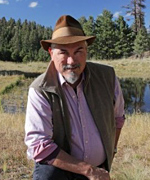 —Al Dulaney
—Al Dulaney
It’s September, and government is relatively quiet. No new laws are before the Legislature, little Congressional action is pending. Everyone is awaiting the results of the November elections.
This is not to say that various initiatives are not moving forward. ADWR is busy with the Drought Contingency Plan negotiations, and ADEQ is preparing to draft new rules on reclaimed water, potentially to include allowing direct potable reuse. The drought is still with us, and planning remains a necessity.
The Bureau of Reclamation has released its 24-month study of Colorado River conditions, and predicts no declared shortage for 2017 — in other words, water elevations in Lake Mead will not drop below 1075 feet above mean sea level, which is the trigger for Tier 1 shortage under the 2007 guidelines. However, there is a 48% probability that water level elevations will be below 1075 feet on January 1, 2018, meaning a significant chance of shortage declaration for that year. And there is a 7% chance of water level elevations dropping below 1025 feet in 2021, which would put the Lower Basin in a Tier 3 shortage — initiating drastic cuts to Arizona. This is better than last year, when a Tier 3 shortage carried a probability of 10% in 2021.
The Lower Basin was able to avoid a shortage declaration for 2017 largely because of the conservation measures put into place by several entities to leave water in Lake Mead in 2016, thus shoring up the water level elevations. Cities such as Phoenix, Scottsdale, and Peoria took water elsewhere to intentionally create a surplus on the lake. Other measures by other entities likewise saved water that remained in Lake Mead. It wasn’t enough to cure the structural deficit between inflows from Lake Powell and deliveries to the three Lower Basin states plus Mexico, but we will not be in shortage in 2017.
The threat of declared shortage on the Colorado River has been hanging over our collective heads for several years, as continuing drought bites deeper. Yet most people continue to get deliveries of as much water as they want without any worries. A concern is rising that the public may not appreciate that drought is an invisible natural disaster that moves very slowly and can last a long time; they may begin to think that hydrologists and water professionals are crying wolf. This must not be allowed to happen. Hydrologists and water professionals must keep educating the public on what drought is and how to survive it. Our AHS Annual Symposium is one way to do this. We can thrive in a tough neighborhood, because we are and will remain prepared.
See you in Tucson!